
Salvete history-lovers!
The holiday season has begun for many of us whom Fortuna has blessed, and even if you might not be one for the orgy of buying and selling presents that usually occurs at this time of year, you no doubt think of food, drink, and friendly gatherings.
And so, I thought it was time for a new, two-part Ancient Everyday series on food and dining in ancient Rome.

Recreation of Roman foods
In this first blog, we’re going to touch briefly on food, what the average Roman diet entailed, and cooking. This is a vast topic, so we’re taking a general look at this subject, a little something to whet your appetite.
In the Roman Empire, diet, and the food that made up that diet, changed according to geographic region and the economic situation of the folk you are talking about. It wasn’t like today where we can just head down the street and buy a pineapple at any time of year. As a rule, there was no mass, global transportation of foods. Romans ate local for the most part, unless you were talking about wine, olive oil, olives and specialty items like garum. We’ll talk about those later.

First off, we need to dismiss the perception that Romans always ate elaborate meals with trays of songbirds, dormice, buckets of wine, and mountains of exotic fruits. This was not a usual occurrence, and when it did happen, it was usually the super-rich or imperial family who ate like that, and then, only once in a while.
The truth is that the Roman diet was rather simple and, dare I say it, probably pretty healthy. Think Mediterranean diet.
Generally, the staples were various grains, often used in a sort of porridge known as puls, and breads made from a species of wheat known as frumentum. There was no such thing as pasta in ancient Rome! Panem et pulswere the go-tos! Beans and lentils were also staples, and research has shown that these, rather than meat, were the breakfast of champions for gladiators!
To hear more about various types of grains from Pliny the Elder, CLICK HERE.
Fruits such as figs, grapes, and olives (yes, olives are technically, a fruit!) were eaten when available, as were a large variety of vegetables that made up the Roman diet. They did not have tomatoes or potatoes in ancient Rome, but they did eat a lot of cabbage, onions, garlic, parsnips, marrows, radishes, lettuce (not Caesar salad BTW!), asparagus, beets, and celery.
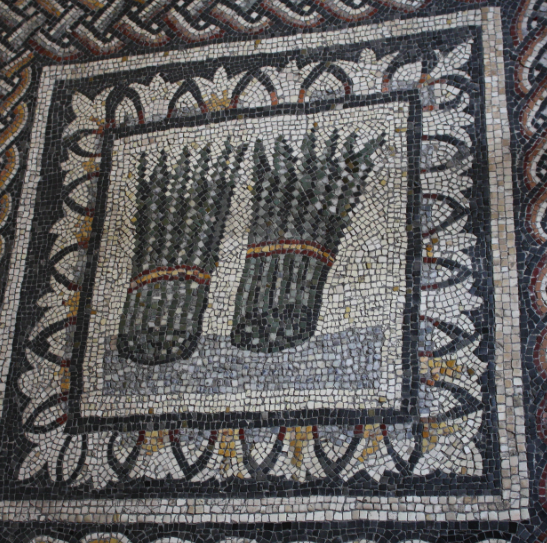
Mosaic depicting asparagus
When it came to meats, these were usually consumed as part of the main meal of the day, however that was not as likely or often for the poor. Sausages and domestic fowl were relatively common, as was pork, the latter being a special feature of certain festivals such as Saturnalia. Oysters and fish were very popular in ancient Rome, but there was the constant challenge of keeping them fresh when being delivered from the seaside to the city. It has been suggested that these were transported live, in barrels, to the places where they were to be consumed.
Needless to say, food poisoning may have been a common occurrence in ancient Rome, especially if one had a taste for oyster and other shell fish.
But let’s not think that there was nothing exotic on the Roman dining table. Well-to-do Romans would have consumed game such as venison or wild boar, snails and dormice (yes, little mice!) that were especially bred for the purpose of consumption, as well as small, wild birds or songbirds. If one attended a really fancy convivium, or banquet, one might even have had the chance to eat some peacock or swan.
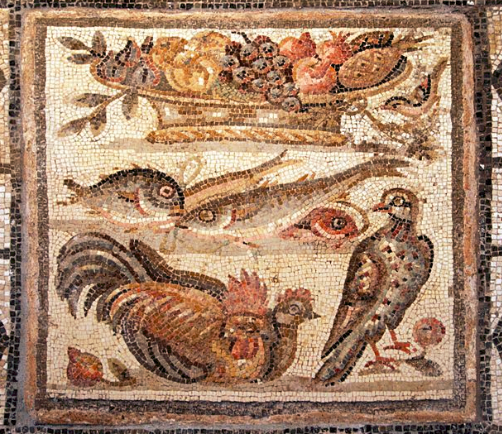
Mosaic depicting typical Roman foods
With all of the foods mentioned above, I would be remiss if I did not make mention of the wide variety of fresh herbs and spices (too many to name here!) that Romans put on their food.
Romans liked their food highly spiced and cooked in sauces. Garum, a fermented fish sauce, was among the most popular. You can read more about garum, by CLICKING HERE.
And there were desserts too! But these were not sweetened with sugar as we know it, but rather with honey. Romans, when they did have sweets, had a variety of cakes, pastries and tarts all sweetened with sticky goodness from our buzzing apian friends.
Lastly, what Roman shopping list would be complete without the two greatest liquid staples in the Empire? I am, of course, talking about wine and olive oil. These were both common in any household and came in varying qualities, depending on one’s income.
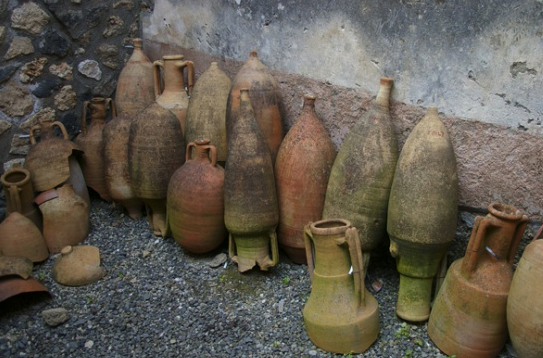
Amphorae that would have been used to transport and store wine and olive oil.
So how and where were all of these foods prepared?
Once again, this depended on the means of the household. Some kitchens were bigger than others, the same as today. In the case of tenement apartments in the Suburra, for instance, they did not have kitchens or cooking spaces which would have taken up much-needed space and been a severe fire-risk in the building.
In the case of tenement dwellers without kitchens of their own, there were communal ovens that were used, as well as plenty of food stalls where meals could be purchased – ancient Rome’s answer to take-out curry!
For those homes that did have kitchens (indoor or outdoor) the space often consisted of a round, or domed oven where a cook-fire was kindled with wood or charcoal. Cauldrons were also suspended over fires, as were frying pans or skillets.
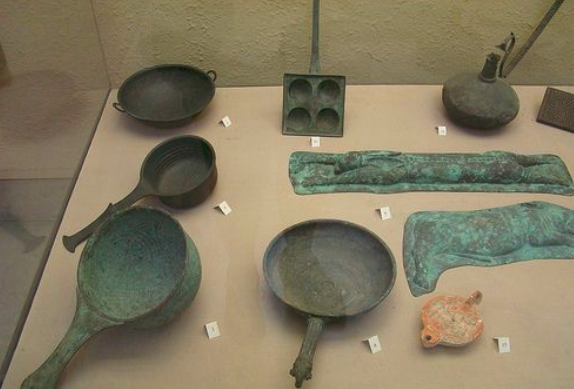
When meat was cooked, it was more often boiled with a sauce, rather than roasted or grilled, although skewered roast meats were available, likely sold street-side.
I tell you, souvlaki has been around a long time!
Preservation of food was also important in ancient Rome, and so the curing and smoking of meats was common, as was the use of salt and pickling in vinegar for preservation.
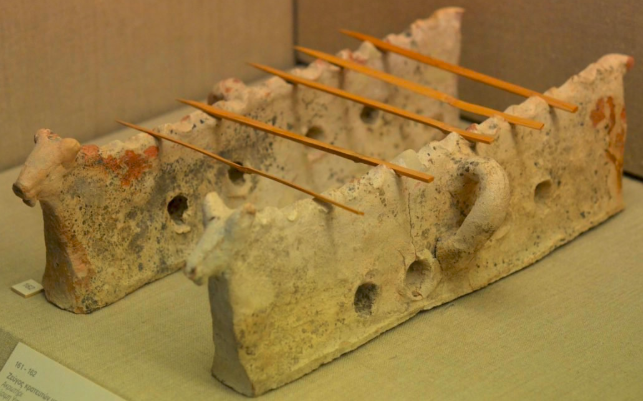
What some archaeologists believe to be a sort of ancient souvlaki rack
Now we come to it, however, the nectar of the gods – wine!
Eight glasses of water a day?
Not in ancient Rome.
The most common drink in ancient Rome was wine. It was usually watered down, as it was considered barbaric to drink it undiluted, which is a shame if you ask me. But watered wine is not so bad. Go on, give it a try!
Just as with olive oil and garum, there were varying qualities of wines made at home and outside of the Italian peninsula.
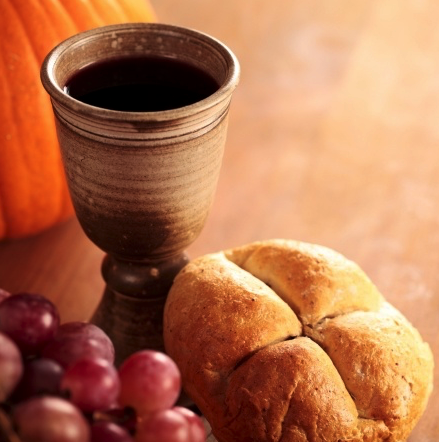
Wine and bread? Yes please!
In addition to the fine Falernian and Chian vintages that might have graced the tables of the wealthy, there was also a wine concentrate that had to be diluted in water.
Among the poor, the drink of choice was posca, a sort of watered down acetumakin to wine vinegar. It might have had a bite, but perhaps it helped to keep one’s innards clean?
I prefer medieval Chianti Classico myself.
In Rome, beer and mead were not widely available and were much more common in the northern provinces.
And milk? Not so much. It was considered uncivilized to drink, the preferred use of dairy being to make cheeses, which were central to the Roman diet.

What’s available in the market today?
As mentioned, we have only scratched the surface of the topic of food in ancient Rome, but I hope this has given you an idea as to the day-to-day flavour of what might have graced the tables of Romans rich and poor.
If you would like to read more about specific recipes, the surviving go-to text for cooking in ancient Rome is by gourmand of the rich and well-to-do of Rome, Apicius.

Apicius’ Roman hamburgers
That concludes part one of this short series on food and dining in ancient Rome.
Stay tuned for part two in which we will be looking at the eating habits of the rich and poor, as well as some of the formalities of dining itself.
Cheers, and thank you for reading!
What Roman food surprises you? If you’ve come across a particularly surprising dish in your own reading or research, please share it with us in the comments below.







Some years ago I was producing “Apicius Sauces” made from original Roman Recipes. I sold them to Museums and Historical Houses in England. They also sold extremely well at the Re enactment Markets as I was involved with the Re Enactors. Chicken cooked the Roman way, as you say, “Boiled with many herbs” is delicious, as are many of the Roman recipes. Thanks for this post which brought back many memories. I am now retired and living in Crete.
That sounds brilliant and delicious, Rita! Do you still produce the sauces for yourself at home in Crete? One of the Roman recipes I constantly go back to is chicken boiled with olives – so tasty! Glad you enjoyed this post and that it brought back some good memories 🙂 Cheers, Rita!
Hello Adam thanks for your reply. Yes I do sometimes make them for ourselves. As a matter of fact I sometimes use them on toast instead of Marmalade. I haven’t tried the one for Chicken boiled with olives but I must,
That’s wonderful! I’m getting hungry now 😉 The recipe for the boiled chicken is in ‘The Classical Cookbook’, which you can check out here: http://geni.us/wEljouR
It’s a fantastic book of ancient recipes I picked up at the British Museum years ago.
Hello again Adam. The first Roman cook book I had which I followed for my sauces was translated by Barbara Flower and Elisabeth Rosenbaum. But then I purchased the book titled The Roman Cookery of Apicius translated and adapted for the Modern Kitchen by John Edwards. Its fabulous and my favourite of the Roman Cookery translations. By the way I once worked alongside Sally Grainger when we were involved with Re Enactors. That was some years ago.
Sounds wonderful, Rita. I’ll have to check out the Roman Cookery book for the modern kitchen! If ever you want to write a guest post about your Roman sauces, do let us know! Some behind-the-scenes sauce creation would be just the ticket! Cheers 🙂
I will certainly think about your kind offer of a guest post Adam. If you would like to give me an idea of what you have in mind.
Sounds good, Rita. I’ll send you an e-mail. 🙂
If you Google Rita Roberts Apicius Sauces you will see a review from EXARC – Experimental Archaeology.
We’ll check it out, Rita! 🙂
Greetings, Adam,
Many thanks for another interesting article. I’d like to talk about wine! Would the Romans have had red and white, as we do, or would it mostly have been red? Would it resemble the wines we know and love or be very different? I’ve read somewhere that they liked it sweetened and herbed (I imagine it would have been something like our mulled wine). Would this have been the usual way to drink it, or would that just have been on special occasions? I’d be very interested in your views on this. Many thanks.
Cheers, Lin! I think that calls for a whole separate Ancient Everyday post itself. I’m putting it on the list! 🙂 Wine was almost always drunk well-watered, but I have also heard about herbs added to wine by Romans, and even lead shavings, but the latter might be false. I’ll look into it for a future post! Glad you liked this one 🙂
I enjoy all your posts, Adam. I look forward to a future post on wine! Cheers!
I found this site very informative, especially on the foods of Ancient Rome & with
there preparation.
Cheers, Lorraine! Glad you liked it. There are many more Ancient Everyday posts on the site. If you search ‘Ancient Everyday’ in the search box of the right side bar on the site, they all come up for you. Thanks for your comment and for stopping by! 🙂